Union Buttons are Living Labor History
A conversation with Isaac Silver on his upcoming exhibition, Emblems of Solidarity: Union Buttons & Labor History.
Natascha Elena Uhlmann
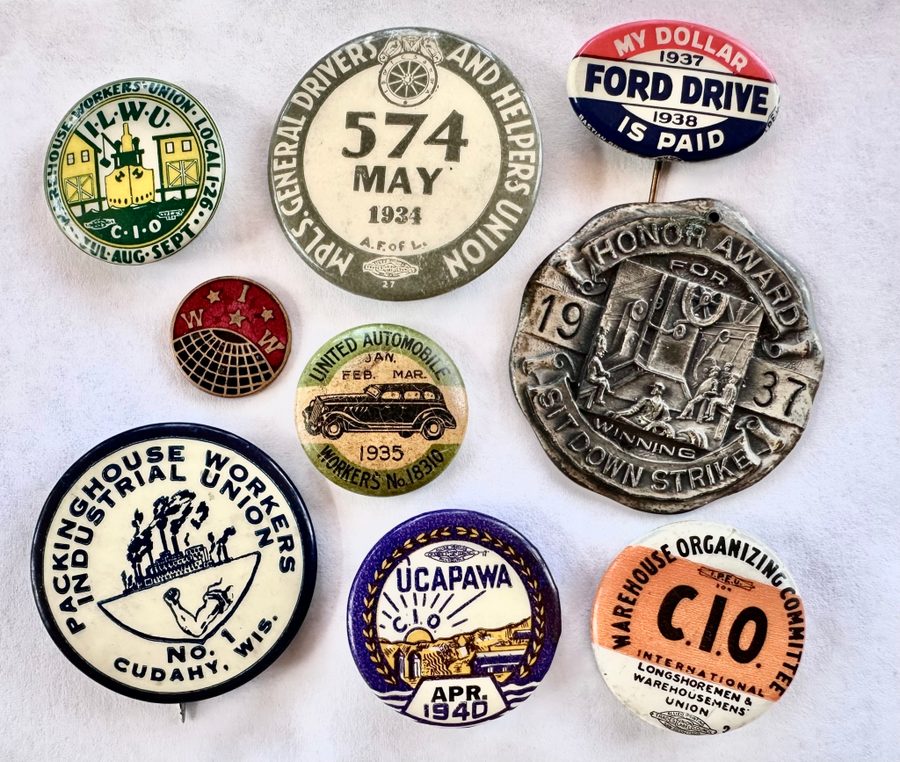
Isaac Silver remembers his mother’s Vietnam antiwar pin as an early entry point into left organizing: “As a small child … watching her radiate anti-war politics wherever she went was something that really shaped [me],” he notes. For Silver, these buttons aren’t just mementos, they’re a visual display of solidarity — and living labor history.
Silver will display this history in a special exhibition at the In These Times office on Wednesday, August 21. Emblems of Solidarity: Union Buttons and Labor History features a curated collection of union buttons from three major industries: the auto sector, shipping and logistics, and the meatpacking industry. In These Times spoke with Isaac on the upcoming exhibition and union buttons as a labor strategy today.
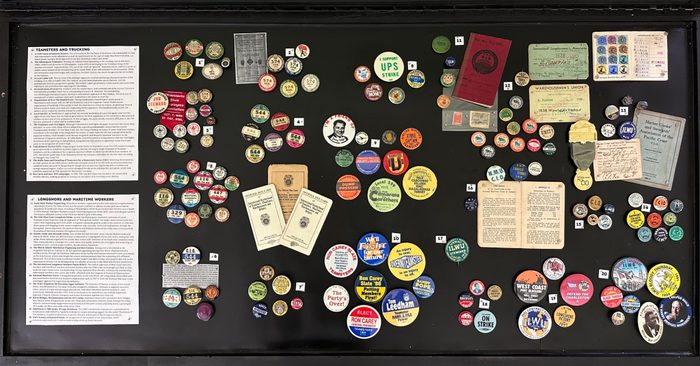
Natascha Elena Uhlmann: Can you tell us about the exhibit and how it came about?
Isaac Silver: I have been collecting political buttons and ephemera for basically as long as I’ve been politically active, for the past couple of decades. Initially it was for issues and organizations that I myself was a member of, and then I became interested in them as a unique type of document of past struggles. I would trade buttons with friends and people I organized with that were connected to different movements, and over time came to seek out specific items that would tell the story of a significant strike or organizing campaign, or things of that nature.
Over time, I had gotten together a pretty large collection of union buttons and curated them into this exhibit, which is organized around three different industries. So it tells the story of rank-and-file worker organizing in the auto industry, and later in the United Auto Workers when it branched out to other industries — as well as meat packing in the food industry and finally, shipping and logistics workers.
Why did you choose those three industries?
Isaac Silver: I wanted to pick things where there’s interesting organizing happening, like contemporary union reform efforts. I wanted to tailor the exhibit to young, newly active rank-and-file union members as a tool for them to become familiar with the history of their unions. I think that the meatpacking one was also a little bit of a nod to Chicago because that was such an important industry here before the 1960s.
Why do you think buttons were so common as a messaging tool? Do we still see this as a labor strategy today?
Isaac Silver: When that button format was invented, it allowed for the mass production of a cheap, easily wearable identifier that people could put on their clothing, and that had really important ramifications for the labor movement. One of the things that I talk about in the exhibit is that different types of buttons have a different audience. So there’s some buttons that would be made to be worn by workers in public-facing industries with a message to be communicated to the general public. This was particularly important in streetcar unions, for example, but also some others. Then there were buttons that were worn as a part of an organizing campaign and really marked a critical step in that campaign. Generally, when you read about organizing drives in the 1930s and earlier, it was often the moment when workers were emboldened to wear a union button openly on the shop floor without fear of being fired or worse, that kind of marked a turning point; it indicated that there was a shift in power on the shop floor.
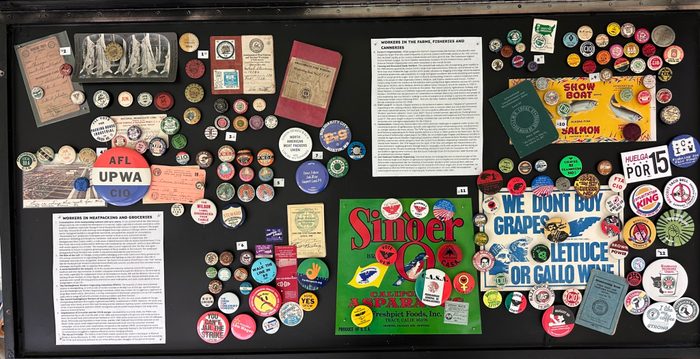
I’m thinking about Will Westlake, the Starbucks barista who was allegedly fired for wearing a suicide awareness pin. Why do you think bosses are so scared of a simple gesture of solidarity?
That’s a great contemporary example. I think we saw something similar with a grocery worker fired for wearing a Black Lives Matter pin. There’s so-called freedom of speech, but then at work, it’s really a dictatorship. All communication in management’s view should be strictly controlled by the company. And so anything where workers are allowed to speak in their own voice is a threat to that control. So it’s both a small thing, but it’sait’s a thread that unravels a really big thing as well.
One of the buttons that I have in the exhibit is from a meatpacking campaign — it’s a shop steward button that was worn by a Black union leader at one of the meatpacking plants in Chicago, and he was fired for showing up to work with his union steward button. That sparked an interracial wildcat strike and walkout in the stockyards that day. That, to me, was such a powerful story because of the role that racism had played in previous efforts to organize in the stockyards. Then, decades later, through the committed anti-racist practice where white and Black workers see this coworker as like their leader, that’s somebody they’re going to follow out
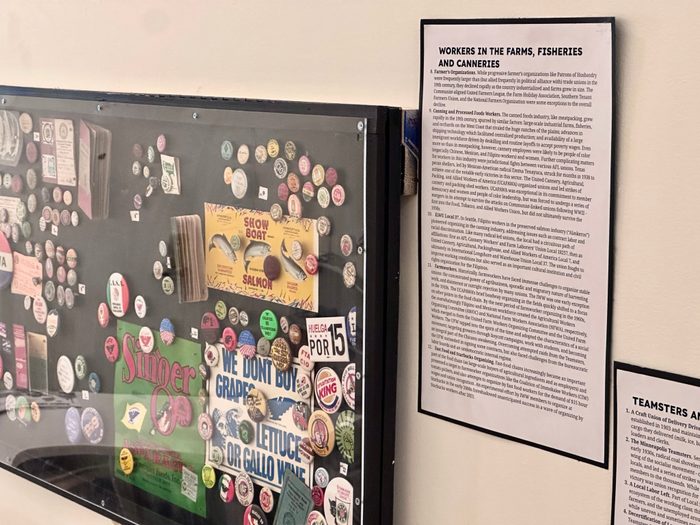
This might be an impossible question to answer, but do you have a favorite pin?
I have favorites of different types. So one of the buttons in the exhibit that I included, which is not strictly a union button, is my mom’s Vietnam antiwar pin.I just remember as a small child,I think that was one of the earliest memories that I have of being politically active.Watching her wear that, and watching her radiate antiwar politics wherever she went was something really shaped my politics and my fascination with these objects So there’s that, then there are some which I think are just so visually striking and are just cool as works of art. In addition, I have union dues buttons for specific months of specific unions when there were very consequential strikes that occurred. What that meant prior to the dues checkoff system, is that when a union member showed up at the monthly meeting or just paid their dues to the shop steward on the job, they would get a button showing that they were current in their dues. It was a visual display of solidarity.
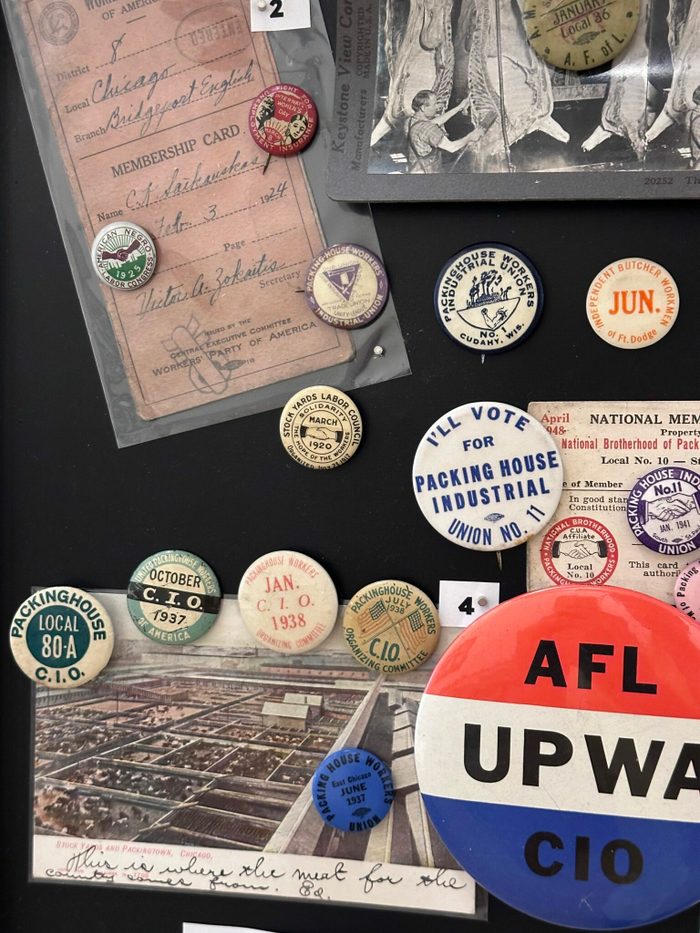
Ultimately, I think what is so powerful is that these are made to be worn by workers themselves. It’s a direct form of worker self-expression.If you have a bottom-up view of the working class movement, this is really the best expression of it …These are things which were actually worn by people on the picket line, by people on the unemployment line, by people in organizing drives, in the mines, in the sweatshops. And so it’s a very tangible connection to that history.
Natascha Elena Uhlmann is a staff writer at Labor Notes.








